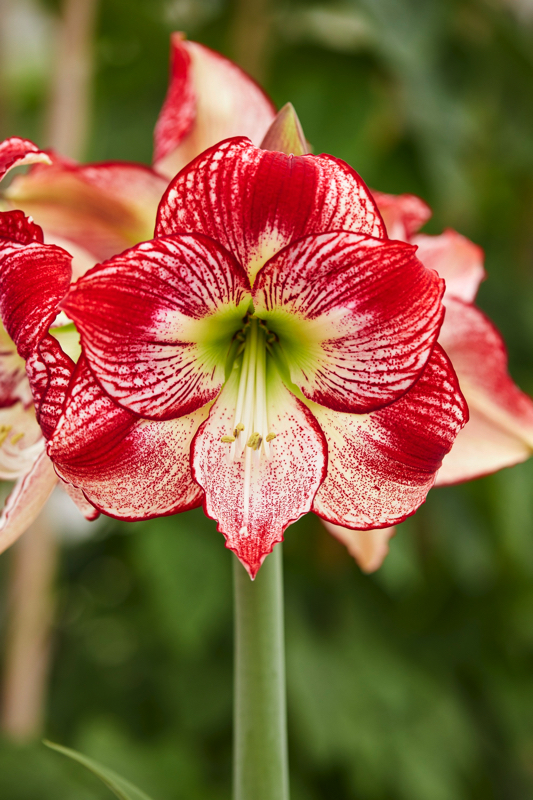01 Aug Go Beyond the Traditional with Unique Amaryllis Varieties
Melinda Myers
Melinda Myers has written more than 20 gardening books, including Small Space Gardening. She hosts The Great Courses ‘How to Grow Anything: Food Gardening for Everyone’ DVD set and the nationally syndicated Melinda’s Garden Moment TV & radio segments. Myers is a columnist and contributing editor for Birds & Blooms magazine and was commissioned by AAS for her expertise to write this article. Myers’ web site is www.melindamyers.com.
Photo credit: photo courtesy of Longfield-Gardens.com
Cutline: Flamenco Queen is a new and unique amaryllis variety with later bloom time.
Go Beyond the Traditional with Unique Amaryllis Varieties
by Melinda Myers
Boost your spirits and winter decor with new shapes and colors of amaryllis. Today there are many beautiful options beyond the traditional red.
Double amaryllis have jumbo flowers with multiple layers of petals. Kick off the season with the early-blooming variety Alaska. Its frilly white petals contrast nicely with the lime green throat and the flowers last for weeks. Early blooming amaryllis are grown in the southern hemisphere and, if planted by early November, they bloom in time for holiday decorating and gift-giving.

Extend amaryllis season with doubles that are grown in the northern hemisphere. Start these amaryllis bulbs any time before January for flowers in mid to late winter. Sweet Nymph has layers of creamy white petals that are decorated with coral pink stripes. The blossoms add romantic charm to any setting. The extra-large flowers of Giant Amadeus change colors as they go from bud to mature bloom. The blossoms start out mostly white with a fine red outline. The color of the petals gradually intensifies to blushing pink, rose, and coral.
Doublet is another stunning winter-blooming double. Its flowers feature narrow petals in a variety of widths, all with red and white candy cane stripes. You can expect two or three flower stalks from each bulb and as many as a dozen flowers. For more subtle beauty, consider double amaryllis Elvas with white petals outlined in red.
New varieties of single amaryllis can be equally dramatic. Opal Star is an early bloomer with slightly longer and narrower petals than most. Its muted, pale red flowers feature a chartreuse and white star in the center that extends to the tips of the petals. Cape Horn has broad, rose-pink petals and a white star. Remember to plant these early-blooming amaryllis in the fall so you can share living bouquets for the holidays.
Keep the flowers coming with varieties that bloom in January and February. Terra Cotta Star is sure to attract attention with its striking colors and exquisite details. The salmon, rose, buttercream and pistachio petals have dark red veining that makes each blossom a standout. Yellow Star is another unique variety with elegant ivory and lime green flowers that are sure to lift your spirits. Rosy Star’s exquisite flowers feature snowy white petals and a rose-pink blush.
Don’t underestimate red amaryllis as there are many exciting variations to choose from. Charisma is an early-blooming single with petals that display an ombre effect of red and white. Gervase and Flamenco Queen are later blooming singles with a similar fade on their petals. For extra bold red and white flowers, consider single amaryllis Spartacus or Minerva, and the double variety Splash.
Order your amaryllis bulbs early for the best selection. When the bulbs arrive, store them in a cool, dry dark place until you are ready to plant. After you pot up the bulbs, place them in a warm, bright location to encourage them to break dormancy. Once the first bud emerges, you can expect to have flowers in two to four weeks. Enjoy all the beauty that growing amaryllis (Longfield-Gardens.com) provides with only minimal care.
Melinda Myers has written more than 20 gardening books, including the recently released Midwest Gardener’s Handbook, 2nd Edition and Small Space Gardening. She hosts The Great Courses “How to Grow Anything” DVD instant video series and the nationally syndicated Melinda’s Garden Moment TV & radio program. Myers is a columnist and contributing editor for Birds & Blooms magazine and was commissioned by Longfield Gardens for her expertise to write this article. Her web site is www.MelindaMyers.com.




Sorry, the comment form is closed at this time.